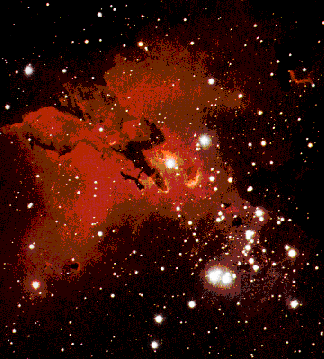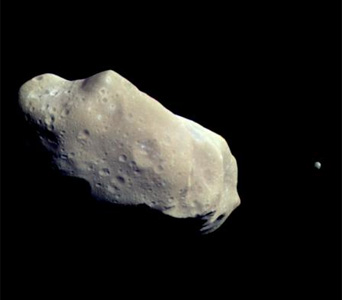Hadean time:
4.5 to 3.8 billion years ago




Hadean time is not a geological period as such. No rocks on the Earth are this old - except for meteorites. During Hadean time, the Solar System was forming, probably within a large cloud of gas and dust around the sun, called an accretion disc. The relative abundance of heavier elements in the Solar System suggests that this gas and dust was derived from a supernova, or supernovas - the explosion of an old, massive star. Heavier elements are generated within stars by nuclear fusion of hydrogen, and are otherwise uncommon. We can see similar processes taking place today in so-called diffuse nebulae in this and other galaxies - such as the nebula M16, shown above left.
The sun formed within such a cloud of gas and dust, shrinking in on itself by gravitational compaction until it began to undergo nuclear fusion and give off light and heat. Surrounding particles began to coalesce by gravity into larger lumps, or planetesimals, which continued to aggregate into planets. "Left-over" material formed asteroids and comets - like asteroid Ida, on the upper right.
Because collisions between large planetesimals release a lot of heat, the Earth and other planets would have been molten at the beginning of their histories. Solidification of the molten material into rocks happened as the Earth cooled. The oldest meteorites and lunar rocks are about 4.5 billion years old, but the oldest Earth rocks currently known are 3.8 billion years old. Sometime during the first 800 million or so years of its history, the surface of the Earth changed from liquid to solid. Once solid rock formed on the Earth, its geological history began. This most likely happened prior to 3.8 billion years, but hard evidence for this is lacking. Erosion and plate tectonics has probably destroyed all of the solid rocks that were older than 3.8 billion years. The beginning of the rock record that is currently present on the Earth is the inception of a time known as the Archaean.
For more on the history of the Solar System, visit the excellent Nine Planets virtual tour of the solar system, or the Views of the Solar System site.
For information about research on other solar systems, visit the excellent Extrasolar Planets Encyclopaedia at the Observatoire de Paris.

Astronomical photographs graciously provided by Frank Roussel, ASTROGOF, Rennes University, France, and by the on-line Messier catalog at the University of Arizona.

